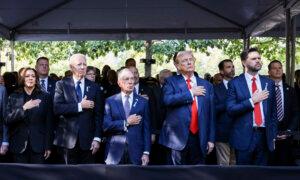The document outlines some of the vice president’s first stated goals for an increasingly Republican voting bloc.
As Vice President Kamala Harris seeks to gain ground with a voting bloc that was critical to former President Donald Trump’s 2016 victory, her presidential campaign released its first detailed goals for rural America on Sept. 12.
After spending much of the previous weeks preparing for Tuesday’s debate with Trump, Harris has resumed her campaign blitz across the battlegrounds, hosting twin rallies on Sept. 12 in North Carolina. Her battlegrounds tour continues through more states in the coming days.
The rural plan touts efforts by both the Biden-Harris administration in Congress and Walz in Minnesota while offering potential rural policies for a Harris-Walz presidency. It calls rural America “the foundation of our country—from the family farms that feed our country to the towns that support small businesses” and discusses goals for expanding the pilot Rural Partners Network, increasing “high-skill, high-wage jobs,” and opening opportunities for small business investments and financing.
“The choice is clear. Vice President Harris and Gov. Walz are running on a promise to serve all Americans, in blue states and red states, urban areas, and rural areas. They will build on the historic achievements of the Biden-Harris administration. They respect who we are and recognize what we need, including lower costs, continued investments, more housing, access to health care, and support for our veterans,” the document reads.
In contrast to Harris’s identity as a California Democrat, her choice of Walz as running mate was seen as an appeal to rural voters, which has been an increasingly shrinking voting bloc for Democrats over the past two decades. Walz is originally from Nebraska and flipped Minnesota’s solidly red First Congressional District in 2006. The rural policy document touts his work on the 2008, 2014, and 2018 Farm Bills in Congress.
“Governors like Beshear and Walz represent and connect with rural communities that have felt left behind in recent elections,” the group wrote, noting Walz’s congressional win in a rural district.
When asked about Walz’s appeal compared with Shapiro’s, Democratic political strategist Zee Cohen-Sanchez told The Epoch Times, “Walz has shown that his strength is shifting red rural voters in his own state already.”
“Walz might not be a shoo-in for Pennsylvania like Shapiro would be; however, overall, I think Walz can speak to a wider range of voters in the important states,” she added.
That rural appeal is not guaranteed, said David Schultz, a political science professor at Hamline University in St. Paul, Minnesota. He said Walz’s record in Congress is reflective of the “very rural, very agricultural” district he represented, but his policies shifted after being reelected as governor in 2022.
“At this point, the Legislature moves to the left, and it starts enacting a lot of what we would call kind of the progressive dream legislation for the Democrats,” Schultz told The Epoch Times.
Despite Trump’s wins across rural America in the previous two elections, the former president is not taking that voting bloc for granted. He launched his “Rural Americans for Trump” coalition on Aug. 1.
Harris, meanwhile, recently hired Matt Hildreth of the progressive Rural Organizing group to serve as her rural engagement director as she seeks to expand her appeal in the final two months of the election.
Original News Source Link – Epoch Times
Running For Office? Conservative Campaign Consulting – Election Day Strategies!


